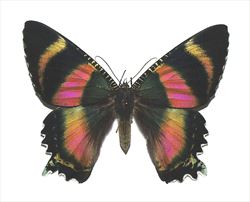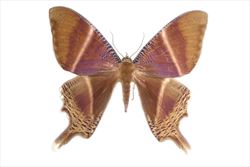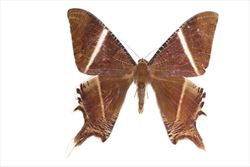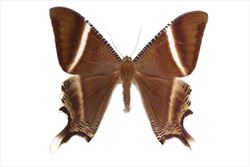OF BIOSECURITY CONCERN
Geometroidea
Uraniidae 686 approximate described species
Worldwide particularly sub-tropical and tropical regions
Euphorbiaceae, Myrtaceae
The character states in the tympanal organs are autapomorphic for this family. The structures display distinct sexual dimorphism: in males, the tympanal organs are located on the posterolateral parts of abdominal tergum two and include anterolateral elements of tergum 3, in females the organs are placed on the anterolateral parts of sternum two; the skeletal parts are not homologous with those of males. A further derived trait is the base of Rs4 in the forewing is connate or stalked with M1, but separate from other branches of Rs. Kristensen (1999) provides a key to subfamilies. Determination of the target species begins at species level.
Atlas of Living Australia. National Research Infrastructure for Australia, NCRIS. http://www.ala.org.au/
ABRS 2009. Australian Faunal Directory. Australian Biological Resources Study, Canberra. http://www.environment.gov.au/biodiversity/abrs/online-resources/fauna/afd/index.html
Barlow HS (1982) An introduction to the Moths of South East Asia, The Malayan Nature Society, Kuala Lumpur.
Butterflies and moths of North America, collecting and sharing data about Lepidoptera. National Biological Information Infrastructure (NBII) Program and the USGS Northern Prairie Wildlife Research Center. http://butterfliesofamerica.com/links.htm
CSIRO Australian National Insect Collection Database. http://anic.ento.csiro.au/database/
CSIRO Ecosystem Sciences. Australian Moths Online. http://www1.ala.org.au/gallery2/main.php
Herbison-Evans D, Crossley S. Families of Moths in Australia. http://lepidoptera.butterflyhouse.com.au/moths.html
Holloway JD, Kibby G, Djunijanti P (2001) The families of Malesian moths and butterflies, Fauna Malesiana handbook 3, The Netherlands.
iBol Terrestrial Biosurveillance, Lepidoptera barcode of life. http://www.lepbarcoding.org/
Natural History Museum, The Global Lepidoptera Names Index. http://www.nhm.ac.uk/research-curation/research/projects/lepindex/search/index.dsml
Plant Health Australia (2012) Combined High Priority Pest List from Industry Biosecurity Plans. In National Plant Biosecurity Status Report, last accessed June 2015. http://www.planthealthaustralia.com.au/biosecurity/emergency-plant-pests/pest-categorisation/categorised-pests/
Robinson GS, Ackery PR, Kitching IJ, Beccaloni GW, Hernández LM (2001) Hostplants of the moth and butterfly caterpillars of the Oriental Region, The Natural History Museum, London.
The Barcode of Life Data Systems http://www.boldsystems.org/
Common IFB (1990) In Moths of Australia, Melbourne University Press, Carlton, Victoria.
Kristensen NP (ed) (1999) Lepidoptera, Moths and Butterflies: Evolution, Systematics and Biogeography (vol. 1). Handbook of Zoology, Walter de Gruyter, Berlin.
Lees DC, Smith NG (1991) Foodplant associations of the Uraniinae (Uraniidae) and their systematic, evolutionary, and ecological significance. Journal of the Lepidopterists’ Society 45(4).
Northern Australia Quarantine Strategy (2015) Entomology Internal Target List. Australian Government Department of Agriculture.
Operational Science Program (2015) Entomology Internal Target List. Australian Government Department of Agriculture.
Plant Health Australia (2012) Combined High Priority Pest List from Industry Biosecurity Plans. In National Plant Biosecurity Status Report, last accessed June 2015. http://www.planthealthaustralia.com.au/biosecurity/emergency-plant-pests/pest-categorisation/categorised-pests/
van Nieukerken EJ, Kaila L, Kitching IJ, Kristensen NP, Lees DC, et al. (2011) Order Lepidoptera Linnaeus, 1758. In Zhang, Z.-Q. (Ed.) Animal Biodiversity: An outline of higher level classification and survey of taxonomic richness. Order Lepidoptera Linnaeus, 1758. Zootaxa. 3148: 212–221.






